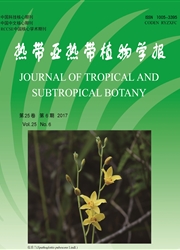

 中文摘要:
中文摘要:
通过种群统计学、格局分析和树干解析等对50a生水杉人工林林分的分化特征进行了研究。结果表明:小个体林木占有相对多数(〉50.4%);林木分化现象显著,特别是树高与材积的分化十分突出,林分已出现一定强度的自然稀疏;基于TSTRAT程式的林木分级结果表明,亚优势木占绝对优势(45.7%),其树冠构成该林分的主林冠;竞争指数依次为优势木级〈亚优势木级〈中庸木级〈被压木级,各级的基尼系数基本上低于全林总计;优势木绝对生长率和相对生长率在林分成熟期以前均大于标准木,且胸径速生期持续时间较标准木长;林分高度生长受压抑程度低于胸径生长;林木分布格局总体呈均匀型,与造林初始基本一致;优势木和被压木为聚集分布,中庸木和枯死木为随机散布,亚优势木的分布型则介于随机和聚集之间。林木种群分化既表现在个体大小的不均等性上,也表现在空间分布的非匀质性上。目前林分结构特征的主要成因可以归结为密度压力下的种内竞争。
 英文摘要:
英文摘要:
To describe the differentiation characteristics of a 50-year-established Metasequoia glvptostroboides plantation, we examined its size structure, spatial pattern and growth process. Small-size individuals accounted for the majority (〉 50.4%). To some extent, self-thinning had occurred, as a result of high differentiation of tree height and volume. Tree-status classification structure based on TSTRAT stratification algorithm demonstrated that co-dominant trees represented an overwhelming portion (45.7%) and formed the general canopy of the stand. Value of competition index was the lowest for dominant class, successively followed by co-dominant, intermediate and suppressed class. Gini coefficient value of each class was basically inferior to that of the whole stand. Both in absolute and relative rates, dominant trees grew faster than standard trees before stand maturation. Furthermore, fast-growth stage of DBH for the former lasted longer than that for the latter. At stand level, DBH growth was more seriously restricted than height growth. The general pattern of all stems remained uniform, the same as onset of the plantation. However, occurrence of divergent tree-classes was spatially heterogeneous, with dominant and suppressed class being aggregated, intermediate and dead class randomly scattered, and co-dominant class intervened between randomness and aggregation. Our results suggested that differentiation of tree population was reflected not only in size inequality but also in heterogeneity of spatial configuration. Current stand structure might attrbute to intraspecific competition induced by high density.
 同期刊论文项目
同期刊论文项目
 同项目期刊论文
同项目期刊论文
 期刊信息
期刊信息
